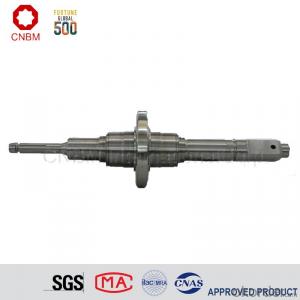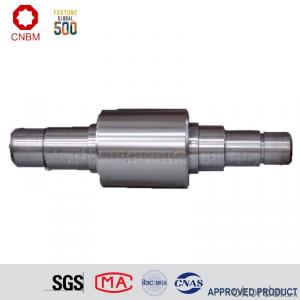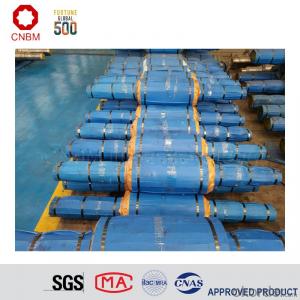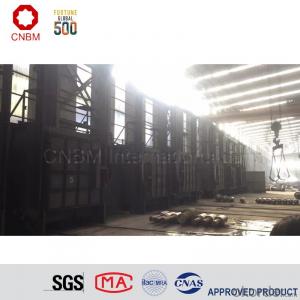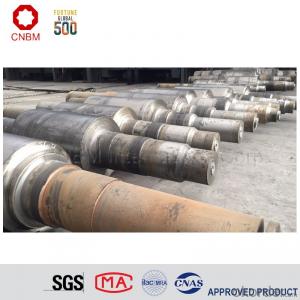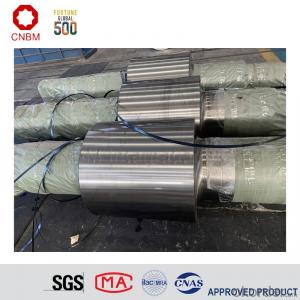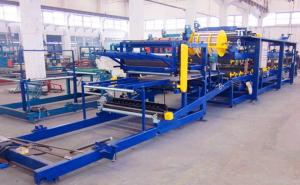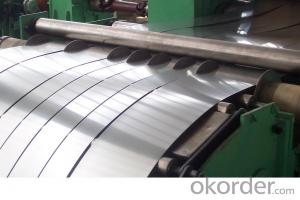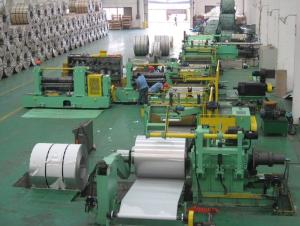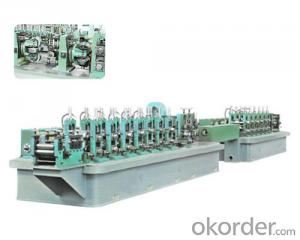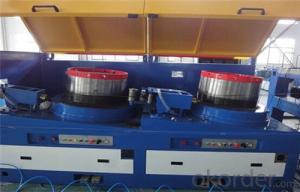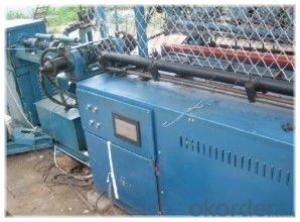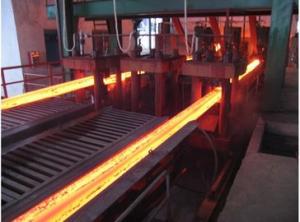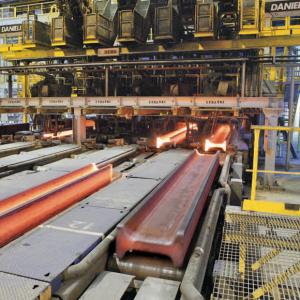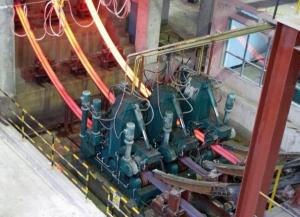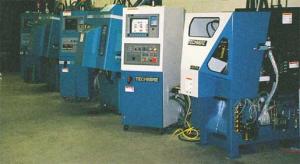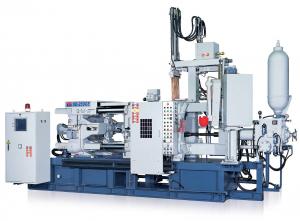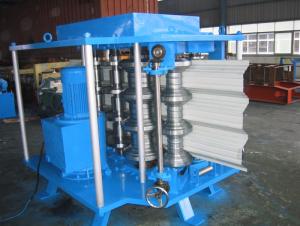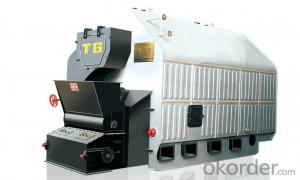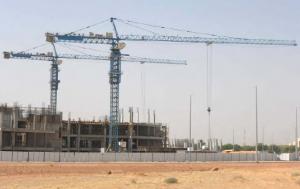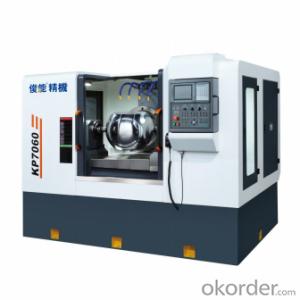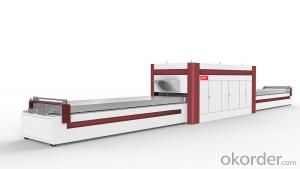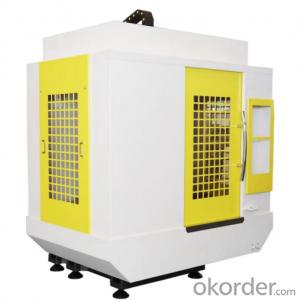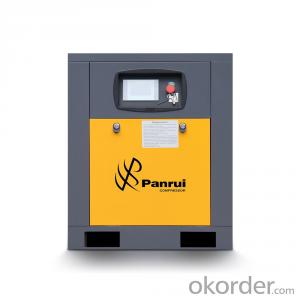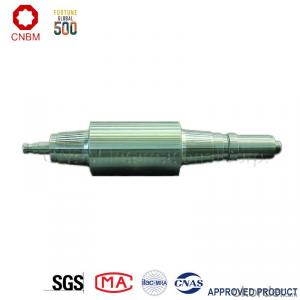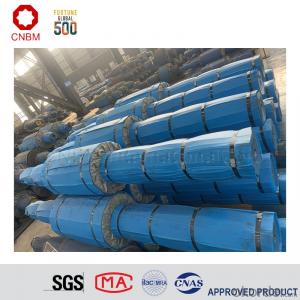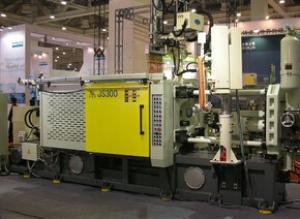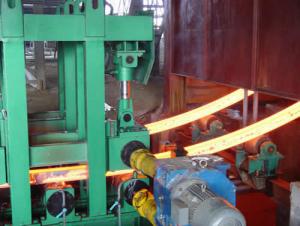Graphitic Steel Roll With High Wear Resistance and High Performance
- Loading Port:
- Tianjin
- Payment Terms:
- TT OR LC
- Min Order Qty:
- 2 m.t.
- Supply Capability:
- 41000 m.t./month
- Option:
- 650X1780X5540; 650X1780X5540; 680X2080X5920
OKorder Service Pledge
OKorder Financial Service
You Might Also Like
Item specifice
Company Profile
CNBM International Corporation (CNBM International) is the most important trading platform of CNBM Group Corporation, a state-owned company under the direct supervision of State-owned Assets Supervision and Administration Commission of the State Council.
CNBM Group is integrated with four business segments: Manufacture, R&D,Sets of equipment and Logistics trading.Mill rolls are our main products.
CNBM International is highly recognized by its business partners and clients all over the world and has established good business relationship with the customers in over 120 countries and regions all over the world.

The product introduction of mill roll
Equipped with advanced technological facilities on melting, casting, forging, heat treating and mechanical machining, our factory has formed 9 professional complete roll manufacturing lines of cast steel, cast iron and forged steel rolls such as strip mill rolls, heavy section mill rolls, wire & bar rolls, special shaped rolls and small-sized cold rolls and specialized production lines of bloom and slab CCM, coke oven equipments and wind power products. Annual production capacity of mill rolls is 500,000 tons, metallurgical equipment is 80,000 tons.

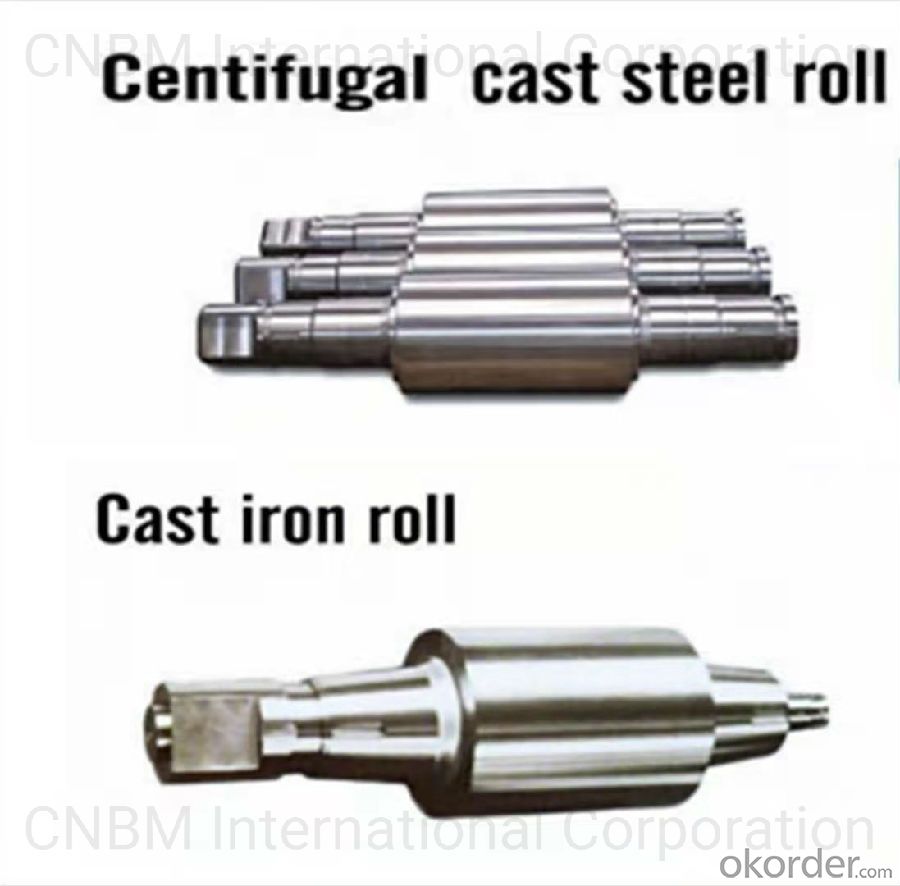
Workshop
Workshop is the core of our company and undertakes all of scientific research work. The company specially produces and supplies all kinds of roll used for hot strip mill, cold strip mill, plate & heavy plate mill, large-sized section mill, universal mill etc.

Products & Specification
| Mill | Application | Material | Product Specification | ||
| Hot Strip Mill | Large-sized vertical roll | Special alloy cast roll, Adamite | All Sizes | ||
| Small-sized vertical roll | Adamite, HiCr iron | ||||
| Roughing work roll | Special alloy cast steel, Adamite, HiCr steel, Semi-HSS, HiCr iron | ||||
| Finish rolling | Early stand work roll | HiCr iron, HSS | |||
| Later stand work roll | ICDP, HSS | ||||
| Finishing back-up roll | Duplex cast steel | D≤¢2000,W≤80t | |||
| Alloy forged steel | D≤¢2000,W≤75t | ||||
| Temper rolling | Work roll | HiCr iron | All Sizes | ||
| Alloy forged steel | |||||
| Back-up roll | ICDP | ||||
| Duplex cast steel | D≤¢2000, W≤80t | ||||
| Alloy forged steel | D≤¢2000, W≤75t | ||||
| Mill | Application | Material | Product specification |
Cold strip mill & Single stand cold mill | Work roll | Alloy forged steel | All Sizes |
| Intermediate roll | Alloy forged steel | ||
| Temper roll | Alloy forged steel | ||
| Back-up roll | Duplex cast steel | D≤¢2000,W≤80t | |
| Alloy forged steel | D≤¢2000,W≤75t | ||
Largesized universal structural mill | Break-down roll | Special alloy cast steel, alloy nodular iron | All Sizes |
| Horizontal collar | High carbon adamite (duplex) | ||
| Vertical collar | High carbon adamite, HiCr iron | ||
| Edger roll Edger roll | High carbon adamite | ||
| Shaft | Alloy forged steel |
| Mill | Application | Marterial | Product Specification | |
| CSP | Vertical Roll | Adamite, Special alloy cast steel, HiCr iron | All Sizes | |
| Roughing work roll | Semi-HSS, HiCr Steel | |||
| Finish rolling | Early stand | HiCr iron, HSS | ||
| Later stand | ICDP, HSS | |||
| Roughing & Finishing back-up roll | Duplex cast steel | D≤¢2000,W≤80t | ||
| Alloy forged steel | D≤¢2000,W≤75t | |||
| Steckel Mill | Vertical roll | Adamite, Special alloy cast steel | All Sizes | |
| Roughing work roll | ICDP, HiCr iron | |||
| Finishing work roll | HiCr iron, ICDP | |||
| Back-up roll | Duplex cast steel | D≤¢2000,W≤80t | ||
| Alloy forged steel | D≤¢2000,W≤75t | |||
| Plate & Heavy plate mill | Rough rolling | 2-hi work roll | Special alloy cast steel, Tool steel | All Sizes |
| 4-hi work roll | HiCr iron, ICDP | |||
| Finishing work roll | HiCr iron, ICDP | |||
| Single stand work roll | HiCr iron, ICDP | |||
| Back-up roll | Duplex cast steel | D≤¢2000,W≤80t | ||
| Alloy forged steel | D≤¢2000,W≤75t | |||
Quality Control
The company has the most advanced experimental and testing equipments in global mill roll industry, including direct-reading spectrometer, spectrum analyzer , X-ray fluorescence analyzer, scanning electronic microscope, energy disperse spectroscopy, X-ray diffractometer, image analyzer, high/low temperature metallographic microscope, X-ray stress meter, brittleness temperature tester, thermal analogue machine, dilatometer, macro and micro hardness tester, OMNISCAM-1X automatic flaw detection, USN60 ultrasonic flaw detector, magnetic powder and non-destructive flaw detection etc,. The advanced inspection equipments and experimental methods provide guarantee for quality control and experiment on material, usability test and performance.
The factories of CNBM invested 2.3 billion RMB for large-scale
CNBM international Corporation has completed equipment and technology upgrade transformation, which was concentrated on three projects, production line of centrifugal casting rolls for hot strip and plate mill, forged roll for cold/hot strip mill, national class technology center and roll material lab. Through upgrade transformation, the following targets have been achideved:
(1)It becomes the world's biggest specialized mill roll maker with the largest production scale, the most complete specifications of products and the most extensive coverage of various rolls used on rolling mill.
(2) The technology of equipments has reached international leading level.
(3) "Mechanization, automation, intellectualization, digitization" of equipments obviously improve the quality control ability.
(4) New types of research instruments improve the R&D capacity of products.
Customers Visit
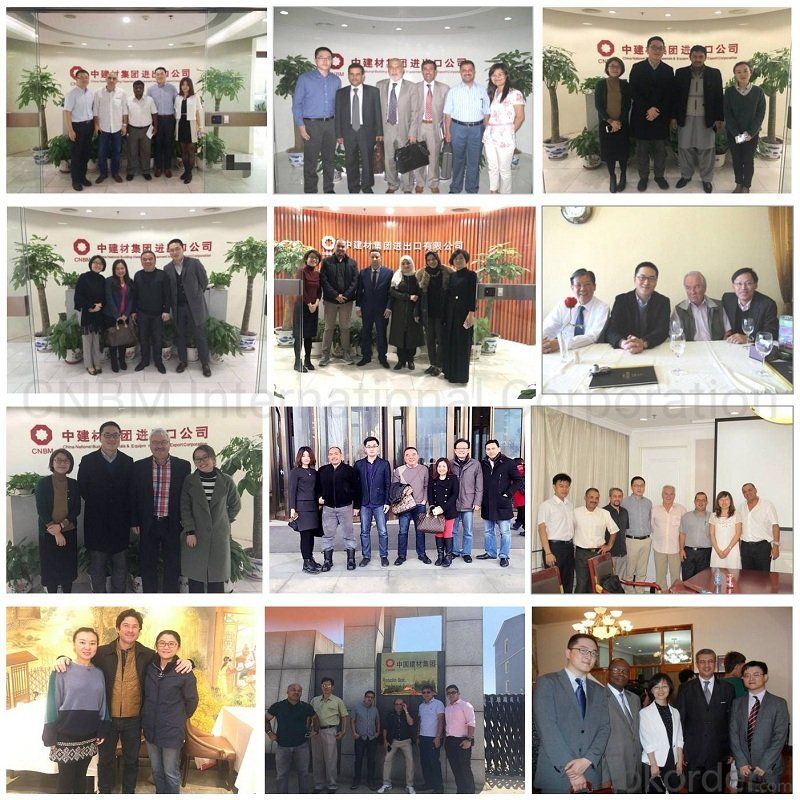
FAQ
Q:Are you a trading company or manufacturer?
A:CNBM is a large-scale central governmental industrial group with its own manufacturing sector, research and development sector, trading sector and logistics sector.
Q:I have some special requirement about specifications.
A:We have a well-rounded product range, which endows us with the capability of applying many special specifications. Please feel free to contact us with yours.
Q:Do you accept OEM service?
A:Yes, we do.
Q:What is your delivery time?
A:It depends on the size/complexity of your order and our own production schedule. Usually we provide a faster delivery than the industry's average.
Q:What is the payment term?
A:Our payment terms are negotiable.
Q:Can I have my own logo on the product?
A:Sure, we can apply your own logo on the products according to your requirement.
- Q:How is the sand mixture prepared for metal casting machinery?
- The sand mixture prepared for metal casting machinery is known as foundry sand. It is a mixture of sand, clay, and water that is carefully prepared to create a mold for casting metal. The process starts with selecting the right type of sand, which is typically silica sand due to its high melting point and ability to withstand extreme temperatures. Once the sand is selected, it is thoroughly cleaned and dried to remove any impurities or moisture that could affect the casting process. The dried sand is then mixed with a binder, usually clay, which helps hold the shape of the mold during the casting process. The clay is mixed with water to form a slurry consistency, ensuring that it evenly coats the sand particles. The sand and clay mixture is then thoroughly mixed together to ensure uniform distribution of the binder. This can be done manually or through mechanical means like a sand mixer. The sand mixture should have the right balance of sand and clay to provide enough strength and rigidity to hold the shape of the mold while still allowing for easy removal of the casted metal. After the sand mixture is prepared, it is ready to be used in the metal casting machinery. The mixture is poured into a pattern, which is a replica of the desired metal part. The pattern is typically made of wood, plastic, or metal and is carefully positioned and packed with the sand mixture to create the mold cavity. Once the mold is prepared, the metal casting machinery is used to melt the metal and pour it into the mold. The heat of the molten metal causes the binder in the sand mixture to harden, creating a solid mold. After the metal has cooled and solidified, the mold is broken apart, and the metal casting is removed. In summary, the sand mixture for metal casting machinery is prepared by selecting the right type of sand, cleaning and drying it, mixing it with a clay binder, and thoroughly mixing the mixture. This prepared sand mixture is then used to create molds for metal casting, providing a solid and precise shape for the poured metal.
- Q:What are the different types of inspection and testing methods used in metal casting machinery?
- There are several types of inspection and testing methods used in metal casting machinery. Some common methods include visual inspection, dimensional inspection, non-destructive testing (such as ultrasonic testing and magnetic particle testing), chemical analysis, mechanical testing, and microstructural analysis. These methods help ensure the quality and integrity of the cast metal components and identify any potential defects or flaws.
- Q:What are the different types of quality control measures used in metal casting machinery?
- To ensure the production of high-quality castings, metal casting machinery utilizes several different types of quality control measures. These measures encompass: 1. Inspection through visual examination: Trained inspectors visually inspect each casting to detect any visible defects such as cracks, shrinkage, porosity, or surface irregularities, ensuring adherence to desired specifications. 2. Assessment of dimensions: Various tools like calipers, micrometers, or coordinate measuring machines (CMMs) are employed to measure the castings' dimensions. This guarantees that the castings fall within specified tolerances and meet desired size and shape requirements. 3. Employment of non-destructive testing (NDT): NDT techniques identify internal defects in castings without causing any damage. Methods like radiographic testing (X-rays or gamma rays), ultrasonic testing, magnetic particle testing, and dye penetrant testing are commonly utilized in metal casting. These techniques enable the detection of defects such as voids, inclusions, or cracks that may not be visible to the naked eye. 4. Verification of chemical composition: Chemical analysis is performed to verify the composition of the metal used for casting. This ensures that the metal alloy meets required specifications and possesses desired properties like strength, hardness, or corrosion resistance. Techniques such as spectroscopy or wet chemical analysis can be utilized to determine the chemical composition. 5. Evaluation of mechanical properties: Mechanical properties testing involves assessing the physical properties of castings, including tensile strength, yield strength, hardness, or impact resistance. Specialized equipment like universal testing machines or hardness testers are utilized to conduct these tests, ensuring that the castings possess the necessary mechanical properties. 6. Examination of the castings' microstructure: Metallographic examination involves preparing samples of the castings, cutting and polishing them, and examining them under a microscope. This aids in identifying the microstructure, determining grain size, assessing the presence of defects, and evaluating metallurgical properties. 7. Process control and monitoring: Process control measures are implemented to monitor and control various variables during the casting process. This includes monitoring the melt temperature, mold temperature, cooling rate, pouring speed, and other process parameters. By closely monitoring and controlling these variables, any deviations or discrepancies can be promptly identified and corrected, ensuring consistent casting quality. By implementing these quality control measures, manufacturers of metal casting machinery guarantee that the produced castings adhere to required specifications, are defect-free, and possess desired properties, ultimately delivering high-quality products to customers.
- Q:How is the casting repaired if defects are found in metal casting machinery?
- If defects are found in metal casting machinery, the casting is repaired by identifying the specific defect and implementing appropriate remedial measures. This may involve using techniques such as welding, grinding, or re-machining to correct any imperfections or inconsistencies in the casting. Additionally, quality control measures are often implemented to identify and prevent future defects in the casting process.
- Q:What is metal mould, machine sand casting?
- General Auto Parts Factory is the metal mold, mechanical sand casting, a large number of pipeline
- Q:What are the common defects that can occur in castings produced by metal casting machinery?
- Some common defects that can occur in castings produced by metal casting machinery include shrinkage, porosity, inclusions, surface defects (such as cracks, tears, or roughness), misruns, cold shuts, and dimensional inaccuracies.
- Q:How do you reduce energy consumption and minimize carbon footprint in metal casting operations?
- Reducing energy consumption and minimizing carbon footprint in metal casting operations can be achieved through various measures. Here are some effective strategies: 1. Optimize furnace operations: Implementing energy-efficient furnaces and improving insulation can significantly reduce energy consumption. It is important to regularly maintain and tune the furnaces to maximize their efficiency. 2. Use energy-efficient equipment: Upgrading to modern and energy-efficient machinery, such as high-efficiency motors and pumps, can reduce energy consumption. Implementing automated systems and controls can also optimize energy usage. 3. Utilize renewable energy sources: Incorporate renewable energy sources like solar panels or wind turbines to power the metal casting operations. This reduces reliance on fossil fuels and decreases carbon emissions. 4. Optimize production processes: Streamline production processes to minimize energy waste. This can be achieved by improving material handling systems, reducing heat loss during melting and pouring, and implementing efficient cooling methods. 5. Recycle and reuse materials: Implement a comprehensive recycling program to minimize waste and conserve resources. Scrap metal and other materials can be recycled and reused, reducing the need for extraction and raw material production, which contributes to carbon emissions. 6. Implement energy management systems: Install energy monitoring systems to track and analyze energy usage patterns. This data can help identify areas of high energy consumption and implement targeted energy-saving measures. 7. Employee training and awareness: Educate employees about energy conservation measures and encourage their active participation in reducing energy consumption. Promote a culture of sustainability within the organization. 8. Collaborate with suppliers and customers: Encourage suppliers to provide energy-efficient materials and equipment. Engage with customers to understand their requirements and optimize designs to reduce material usage and energy needs. 9. Continuous improvement and innovation: Invest in research and development to identify and adopt new technologies that further reduce energy consumption and carbon footprint. Stay updated with industry trends and best practices. By implementing these strategies, metal casting operations can effectively reduce energy consumption and minimize their carbon footprint, contributing to a more sustainable and eco-friendly manufacturing process.
- Q:How does metal casting machinery handle the removal of sand from castings?
- Metal casting machinery uses several methods to handle the removal of sand from castings. One common method is called shakeout, which involves the use of a vibrating table or conveyor belt to shake off the sand from the castings. The vibrations help to loosen the sand particles, allowing them to separate from the castings. Another method is called blasting, where high-pressure air or abrasive materials are used to remove the sand. This process is particularly effective for intricate or hard-to-reach areas of the casting. In some cases, the castings may undergo a process called shot blasting, where small metal pellets are blasted at high speeds onto the castings. This helps to not only remove the sand but also smooth out any rough surfaces or imperfections on the castings. After the sand is removed, the castings may go through a cleaning process to further remove any remaining sand particles. This can involve techniques such as water or chemical baths, brushing, or tumbling. Overall, metal casting machinery employs various techniques to handle the removal of sand from castings, ensuring that the final product is clean, smooth, and ready for further processing or use.
- Q:What are the different types of metal casting machinery used for specific applications?
- There are several different types of metal casting machinery used for specific applications. These machines are designed to efficiently and accurately produce metal castings in various shapes and sizes. Some of the most common types of metal casting machinery include: 1. Die Casting Machines: These machines are used to produce high-quality metal castings with excellent surface finishes. Die casting is commonly used for producing complex shapes and parts with tight tolerances. The machines use a reusable steel mold, known as a die, which is filled with molten metal under high pressure. 2. Sand Casting Machines: Sand casting is one of the oldest and most widely used methods of metal casting. Sand casting machines are used to create molds made of sand, which are then filled with molten metal. This process is suitable for producing large and heavy castings, such as engine blocks, pipes, and large gears. 3. Investment Casting Machines: Also known as lost-wax casting, investment casting machines are used to produce complex and intricate metal castings. The process involves creating wax patterns, which are then coated with a ceramic shell. The wax is melted out, leaving a cavity that is filled with molten metal. Investment casting is often used in the production of aerospace and automotive components. 4. Continuous Casting Machines: Continuous casting machines are used to produce long and continuous metal castings, such as bars, rods, and pipes. The process involves continuously pouring molten metal into a water-cooled mold, which solidifies the metal as it passes through. This method is highly efficient and cost-effective for producing large quantities of metal castings. 5. Centrifugal Casting Machines: Centrifugal casting machines are used to produce cylindrical or tubular metal castings. The process involves rotating a mold at high speeds while pouring molten metal into it. Centrifugal force distributes the molten metal evenly, resulting in a dense and defect-free casting. This method is commonly used for producing pipes, tubes, and other cylindrical components. 6. Vacuum Casting Machines: Vacuum casting machines are used to produce high-quality metal castings with minimal porosity and defects. The process involves placing a pattern or mold in a chamber, which is then evacuated to create a vacuum. Molten metal is then poured into the mold, allowing the vacuum to draw the metal into the mold's cavities. This method is often used for producing jewelry, dental implants, and other small and intricate castings. In conclusion, the choice of metal casting machinery depends on the specific requirements of the application. Each type of machine has its own advantages and limitations, and understanding these factors is crucial for achieving optimal results in metal casting processes.
- Q:How are the defects related to machining prevented in metal casting machinery?
- Various measures and techniques can be utilized to prevent defects associated with machining in metal casting machinery. To begin with, the prevention of defects relies heavily on the proper design and engineering of the machinery. This entails ensuring that the machine possesses structural integrity, employing suitable materials and dimensions to withstand the forces and stresses involved in the casting process. Doing so helps to avert problems like excessive vibrations and misalignment, which can result in machining defects. Maintenance and inspection of the machinery on a regular basis are also of utmost importance. This includes the careful examination and calibration of the various components and systems, such as cutting tools, spindles, bearings, and guides, to guarantee that they are in optimal condition. Any indications of wear and tear or malfunctions must be addressed promptly to prevent defects during machining. Moreover, the implementation of proper operating procedures and practices can significantly diminish the risk of defects. This necessitates training and educating machine operators on the correct techniques, settings, and parameters for machining different types of metals and castings. Having skilled and experienced operators who possess a comprehensive understanding of the machinery and its capabilities can significantly reduce defects. An additional critical aspect is the utilization of high-quality cutting tools and materials. The application of tools that are specifically suitable for the given machining requirements and materials being casted can greatly enhance the precision and quality of the machining process. Regularly replacing worn-out tools and employing appropriate lubricants and coolant can also contribute to defect prevention. Furthermore, the incorporation of advanced technologies and automation in metal casting machinery can offer further protection against defects. These technologies, such as computer numerical control (CNC) systems, can provide precise control and monitoring of the machining process, thereby diminishing the chances of human errors and inconsistencies. Real-time monitoring and feedback systems can also aid in the identification and rectification of any issues during machining, thereby preventing defects from occurring. In conclusion, a combination of proper machine design, regular maintenance, skilled operators, high-quality tools, and advanced technologies can effectively prevent defects associated with machining in metal casting machinery.
1. Manufacturer Overview |
|
|---|---|
| Location | |
| Year Established | |
| Annual Output Value | |
| Main Markets | |
| Company Certifications | |
2. Manufacturer Certificates |
|
|---|---|
| a) Certification Name | |
| Range | |
| Reference | |
| Validity Period | |
3. Manufacturer Capability |
|
|---|---|
| a)Trade Capacity | |
| Nearest Port | |
| Export Percentage | |
| No.of Employees in Trade Department | |
| Language Spoken: | |
| b)Factory Information | |
| Factory Size: | |
| No. of Production Lines | |
| Contract Manufacturing | |
| Product Price Range | |
Send your message to us
Graphitic Steel Roll With High Wear Resistance and High Performance
- Loading Port:
- Tianjin
- Payment Terms:
- TT OR LC
- Min Order Qty:
- 2 m.t.
- Supply Capability:
- 41000 m.t./month
- Option:
- 650X1780X5540; 650X1780X5540; 680X2080X5920
OKorder Service Pledge
OKorder Financial Service
Similar products
New products
Hot products
